Here are some very photogenic mammals seen in Calgary in April 2018 by Tony LePrieur. The Beavers were photographed in Fish Creek Provincial Park, and the Porcupine in Carburn Park.







You can see more of Tony’s photos on this page.
Here are some very photogenic mammals seen in Calgary in April 2018 by Tony LePrieur. The Beavers were photographed in Fish Creek Provincial Park, and the Porcupine in Carburn Park.







You can see more of Tony’s photos on this page.
Here are a couple of the largest rodents you can see in Carburn Park in SE Calgary.

Muskrat, Carburn Park, May 23, 2017. Photo by Tony LePrieur.

Beaver, Carburn Park, May 23, 2017. Photo by Tony LePrieur.
These two species can sometimes be confused for each other, especially when they are swimming. Of course the Beaver is much larger but sometimes size is hard to judge in the field. Beavers have big flat tails but they are not always visible. Muskrats have long tails without fur. These photos show some of the differences that help with identification when the other traits aren’t clear: the big wide head with large nose and prominent ears of the Beaver, and the small face and often hidden ears of the muskrat. Fur colour can vary but around here muskrats seem to usually be reddish like this one.
Posted by Bob Lefebvre
Photographs of spring birds, by Tony LePrieur.

Yellow-rumped Warbler (Audubon’s), Bridlewood Wetland, April 30, 2017. Photo by Tony LePrieur.
Yellow-rumped Warblers are usually among the first warblers to pass through Calgary on Spring migration, along with Orange-crowned Warblers. Most of the ones we get here are the Myrtle subspecies, the eastern and northern form, which have a white throat and a more prominent black mask. They breed in the boreal forest. The Audubon subspecies, shown here, breeds in the western mountains. This year, quite a few Audubons were reported here. There is talk that the two subspecies will be split again into two separate species, so it is important to note which one you see, especially if you are recording your sightings on eBird.

Common Grackle, Bridlewood Wetland, April 30, 2017. Photo by Tony LePrieur.
The Bridlewood Wetland is located just north of Spruce Meadows, on James McKevitt Road in SW Calgary. It is a small wetland but has a trail around it and a bridge from which to view the birds.
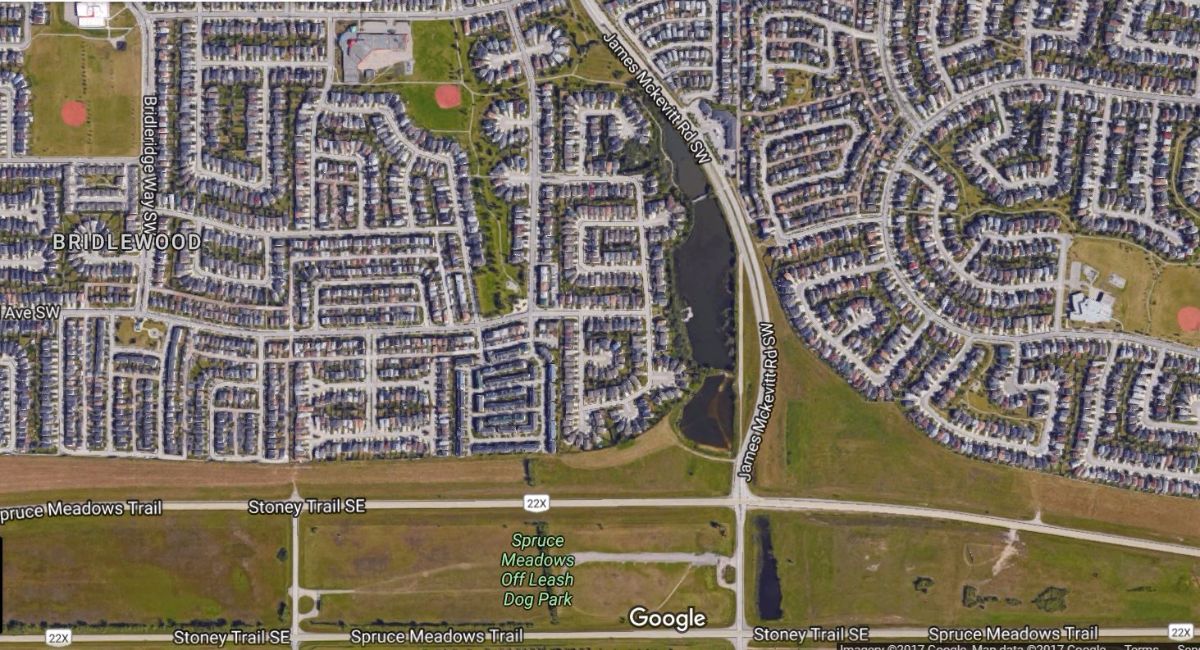
The Bridlewood Wetland in SW Calgary.
The rest of the photos were taken in Carburn Park on the Bow River in SE Calgary.

Common Goldeneye (female), Carburn Park, April 30, 2017. Photo by Tony LePrieur.

Common Merganser (female), Carburn Park, April 30, 2017. Photo by Tony LePrieur.

Lesser Yellowlegs, Carburn Park, April 30, 2017. Photo by Tony LePrieur.
On spring migration, we get more Lesser Yellowlegs than Greater Yellowlegs in the city. But we do get both species. The Lesser is slighter, with a smaller head, and the bill is about the length of the head from front to back, as with this bird. The Greater Yellowleg’s bill is about one and a half times the head length, and often slightly curved upwards.

Song Sparrow, Carburn Park, April 30, 2017. Photo by Tony LePrieur.
This Song Sparrow is missing its tail. Birds don’t molt their tail feathers all at once, so a missing tail probably indicates that the bird narrowly survived an attack by a predator.

Beaver, Carburn Park, April 30, 2017. Photo by Tony LePrieur.
See more of Tony’s photos on his Flickr page.
Here are the last of Tony LePrieur’s summer photos from the Calgary area for this year.

Great Horned Owls, Fish Creek Park, August 12, 2016.

Black-crowned Night-Heron (juvenile), Fish Creek Park, August 12, 2016.

American Beaver, Fish Creek Park, August 12, 2016.
The remainder of the photos below were taken on the weekend of August 28, 2016, in Carburn Park and at Frank Lake.

Cedar Waxwings (juveniles).

Cedar Waxwings (juveniles).

Downy Woodpecker.

Western Grebes.

Western Grebe.

Solitary Sandpiper.

Baird’s Sandpiper.

American Avocet.

Lesser Yellowlegs.
Tony LePrieur took these photos on the weekend of July 23-24, 2016. The Stilts were at Frank Lake; the rest in Fish Creek Provincial Park in Calgary.

Black-necked Stilt chick.
Black-necked Stilts are a relatively new arrival in Alberta. They were first observed to breed in Canada in 1977, and are now found in several provinces. They breed as far north as the Edmonton area now. We are lucky to be able to see them breeding at many areas in the region, including at Frank Lake and Weed Lake.

Black-necked Stilt adult.

House Wren.

This looks like a young LeConte’s Sparrow.

And some mammals: North American Beaver…

… and White-tailed Deer fawn.
Posted by Dan Arndt
My last two outings with the Friends of Fish Creek Spring Birding course were at Carburn Park, both on Thursday, April 17 and Sunday, April 20. Both days had their high points, and so I’ll be mixing and matching photos from each of those days here.
While each day we did the route a little differently, the best birds were always in the same spots. On Sunday, we headed down to the Eric Harvie Bridge then walked back along the river with the sun behind us. While there weren’t too many birds near the bridge itself, as we moved northward we found our first Common Goldeneyes, an American Beaver, and shortly thereafter, a lone Muskrat above the beaver’s dam!
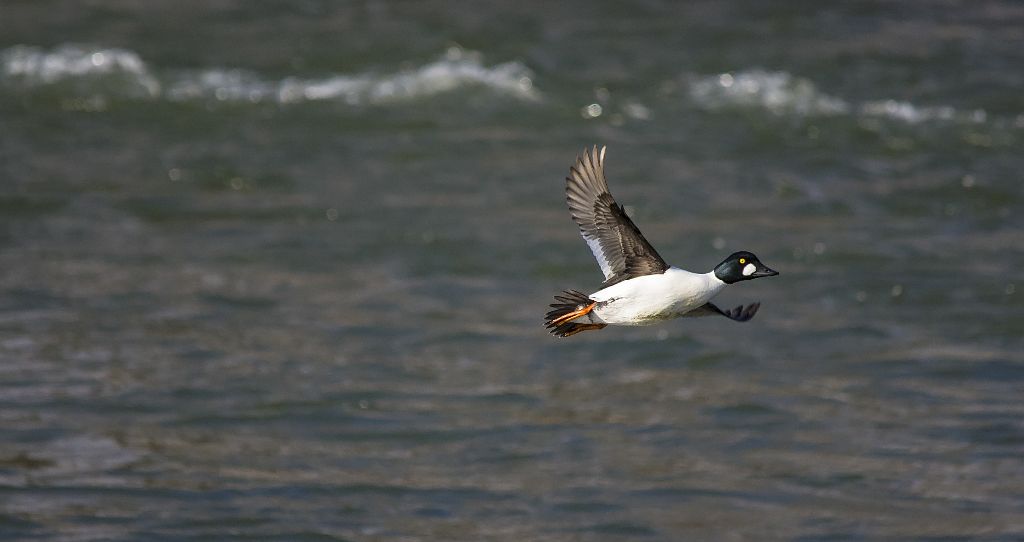
Common Goldeneye
Carburn Park – April 20, 2014
Pentax K-5 + Sigma 150-500@500mm
1/2000sec., ƒ/6.3, ISO 800
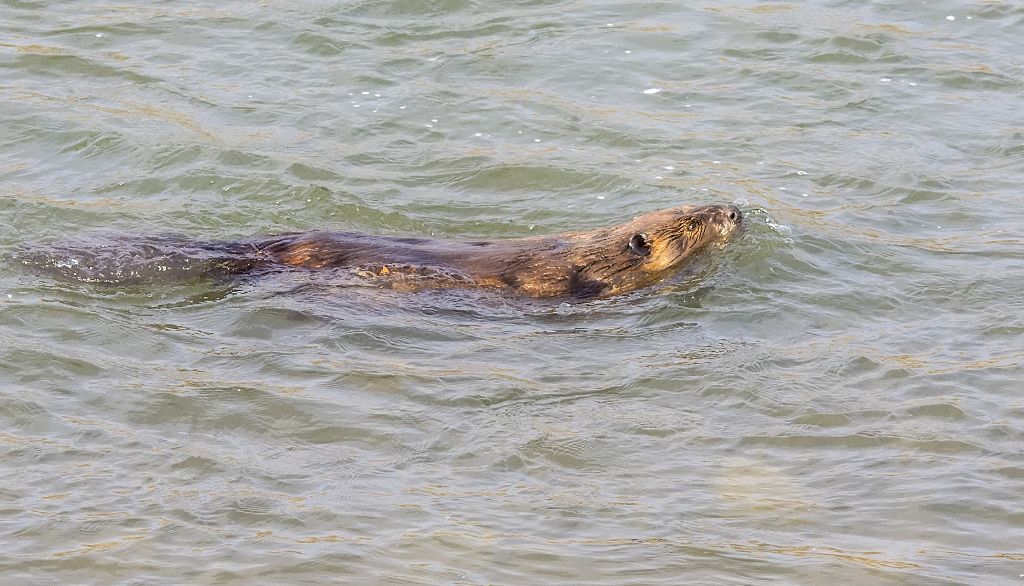
American Beaver
Carburn Park – April 20, 2014
Pentax K-5 + Sigma 150-500@200mm
1/1000sec., ƒ/6.3, ISO 2000
We were also treated to some vigorously displaying Downy Woodpeckers, chasing each other up and down from tree to tree. These two especially were really going at it!
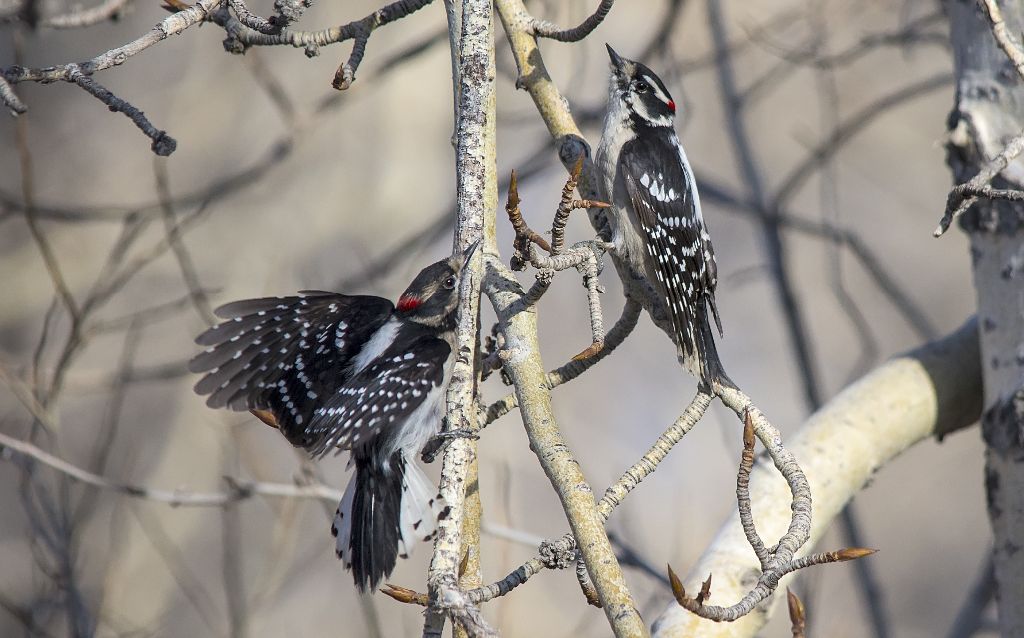
Downy Woodpeckers displaying
Carburn Park – April 20, 2014
Pentax K-5 + Sigma 150-500@500mm
1/2000sec., ƒ/6.3, ISO 800
We headed up the river, seeing a few Tree Swallows, a few Ring-billed and Franklin’s Gulls, and even heard a lone Song Sparrow calling from across the river before we headed back into the denser foliage. Most interestingly though was a little spot we had found on Thursday which was host to half a dozen Ruby-crowned Kinglets was still holding one little one singing away while the sun shone bright…. unlike Thursday, which was cloudy, gloomy and rather snowy!
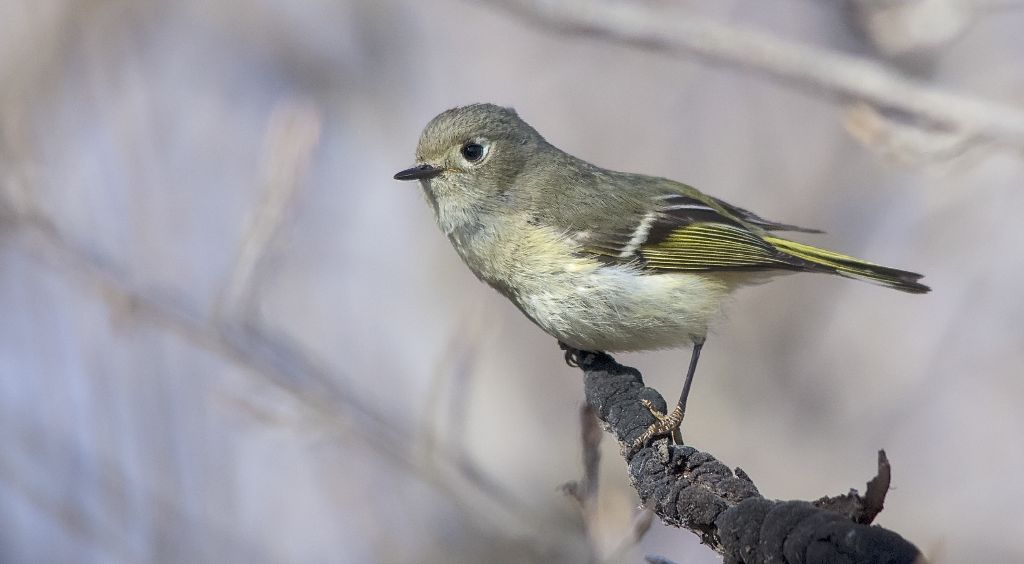
Ruby-crowned Kinglet
Carburn Park – April 20, 2014
Pentax K-5 + Sigma 150-500@500mm
1/1600sec., ƒ/6.3, ISO 1250
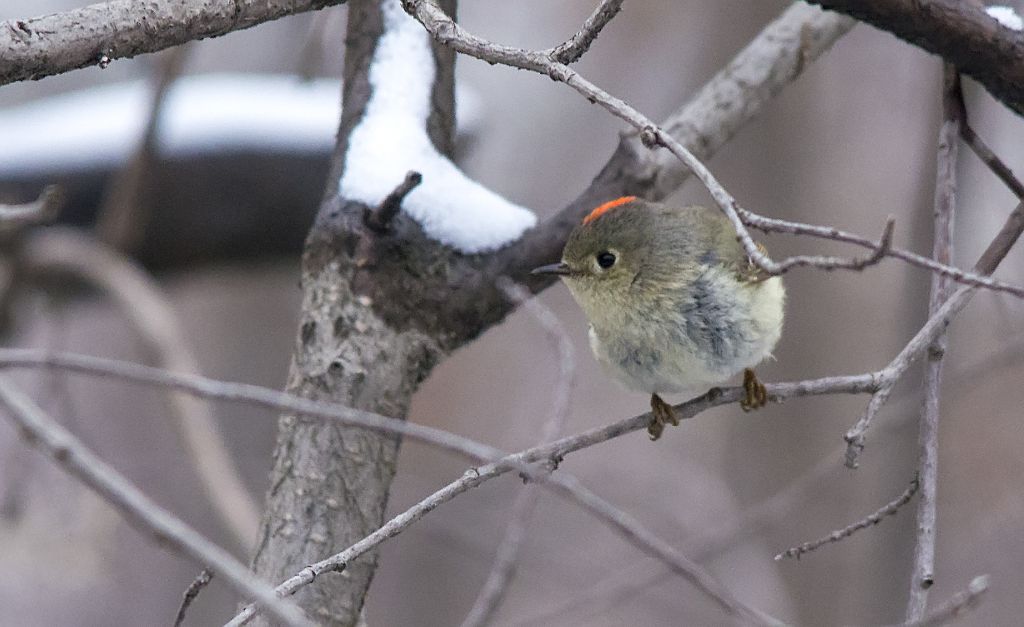
Ruby-crowned Kinglet
Carburn Park – April 17, 2014
Pentax K-5 + Sigma 150-500@500mm
1/800sec., ƒ/6.3, ISO 3200
Up on the north end of the park we saw the local nesting pair of Bald Eagles in the distance, and both days it appeared that the female was still on the nest, brooding her eggs, while dad hunted for dinner.
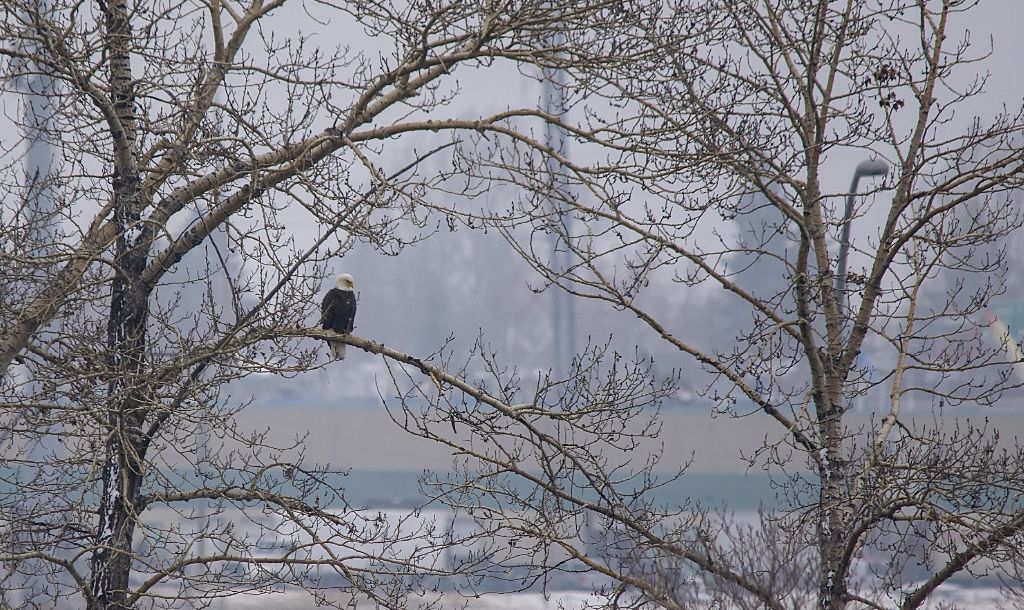
Bald Eagle near nest
Carburn Park – April 17, 2014
Pentax K-5 + Sigma 150-500@500mm
1/800sec., ƒ/6.3, ISO 500
The real highlight of the trip on Thursday though was seeing this flock of nearly a hundred swallows, both Violet-green (look for the ones with the white rump band above the tail) and Tree Swallows (all the rest of them, with the bluish-black backs) flying low over the river chowing down on their lunch of freshly hatched insects. While I had initially guessed that we had seen about four or five Violet-green Swallows, looking back over at my photos I was able to find at least 10 individuals, the largest number of that species I’ve seen in Calgary at once!
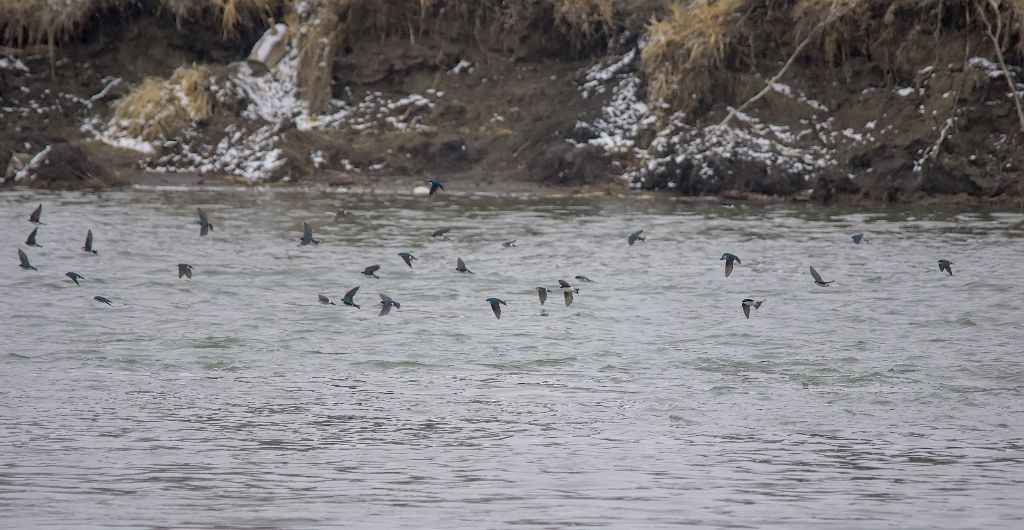
Violet-green and Tree Swallows
Carburn Park – April 17, 2014
Pentax K-5 + Sigma 150-500@500mm
1/800sec., ƒ/6.3, ISO 400
Of course, they weren’t there in any great numbers on Sunday, which was much warmer, and much nicer weather, but there was a beautiful Mourning Cloak butterfly, my first of the season, sunning itself near the second of the large ponds. It was a great end to a great day!
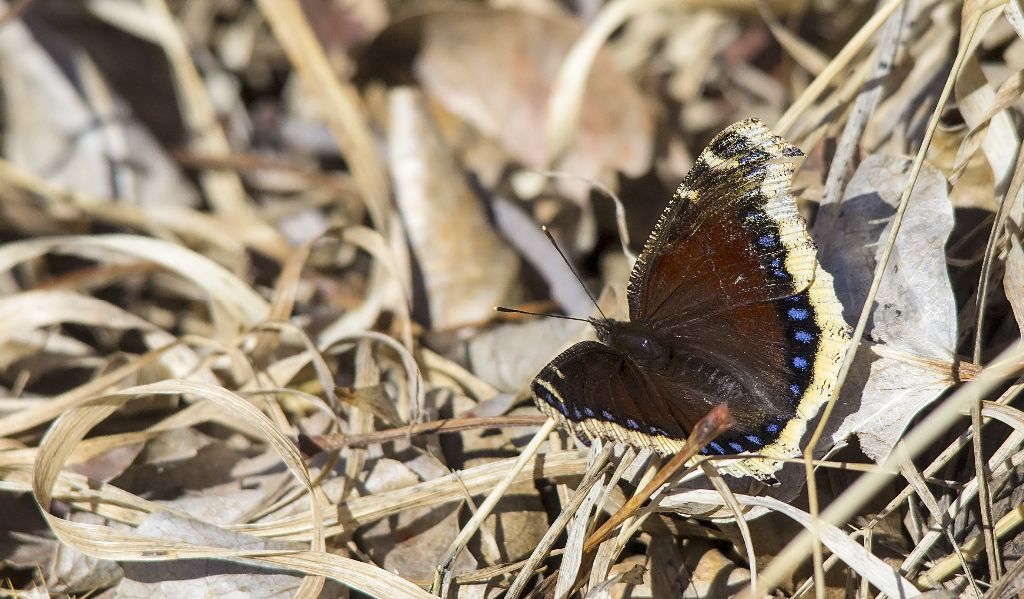
Mourning Cloak butterfly
Carburn Park – April 20, 2014
Pentax K-5 + Sigma 150-500@500mm
1/1600sec., ƒ/6.3, ISO 1000
Thanks again for reading, and good birding!
Last week we went for a walk through the Weaselhead area of SW Calgary. It was very wet and the rivers were high, but we did manage to find some nice birds.
Eastern Phoebes are nesting under both of the wooden bridges…
There are lots of Least Flycatchers in the area…
It appears that Beavers have chewed through this retaining wall, just to make it easier for them to get from the forest to their pond…
We saw this male Calliope Hummingbird do its spectacular U-shaped display flight, where it climbs to a height of about 80 feet, and then dives rapidly towards the ground, and up again…
We never saw any Pileated Woodpeckers, but there is evidence of their activities on many of the big trees…
Cliff Swallows at their mud nests under the bridge over the Elbow River…
A Spotted Sandpiper was feeding on top of some logs in the river…
Cedar Waxwings were busy flycatching along the waterways…
And there were several Red Squirrels, looking for handouts…
Posted by Bob Lefebvre
Guest Post: Coyote and Beaver
The amazing sequence of photographs below was taken last week by Rob English, who kindly shared them with us. This interaction between a Coyote and a Beaver took place at the large pond just North of the highway 22X bridge, on the west side of the Bow River in Fish Creek Park. The photos were taken on two consecutive days, so this is a persistent Coyote (assuming it is the same one both days).
Although this is a birding blog, we are interested in all aspects of nature, and we particularly love mammals. One just doesn’t get the chance to see and photograph mammals as often as birds. And one is rarely lucky enough to see an encounter like this.
If you have interesting nature photos that you’d like to share, please send them to us and we may post them here.
Thanks again to Rob English.
He got away.
Maybe if I sneak up from this angle…
He looks pretty big…
How about a sudden attack from this side?
Pretty big from this side, too.
Back to Meadow Voles…
Coyotes are very opportunistic feeders, and have been known to eat Beavers. But a lone Coyote would have quite a bit of trouble with a full-grown Beaver like this one. As you can see, the Coyote is quite hesitant to attack.
Photos by Rob English
Posted by Bob Lefebvre